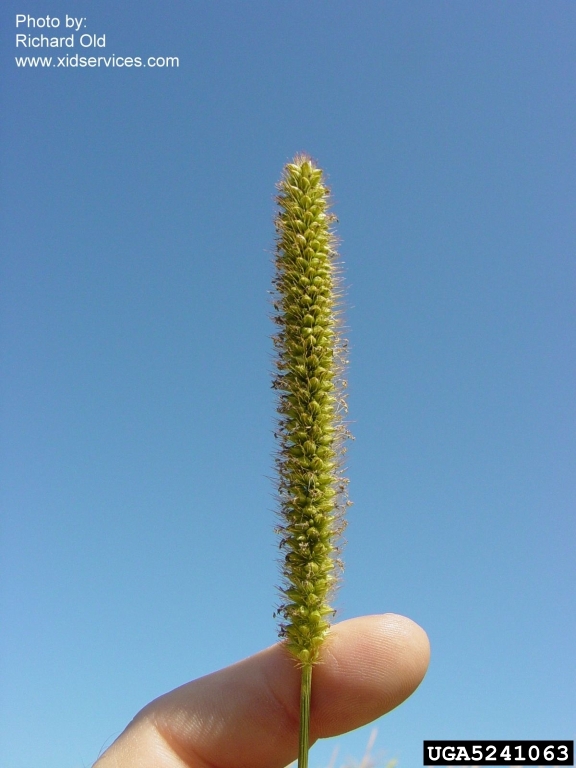Setaria pumila (Poir.) Roem. & Schult.
Smooth Millet, Yellow Foxtail| Category |
|---|
| Grass |

Description
Yellow foxtail is a summer annual grass.Stem
Stems grow 1 to 2 feet (30 to 60 cm) tall and branch at the base. The grass tends to grow in clumps because the stems often tiller, or root, at the lower joints. Stems are smooth, and leaf sheaths are smooth and flattened; the back edge forms a sharp crease, especially at the base of the plant.Leaves
Leaf blades are 4 to 12 inches (10 to 30 cm) long and about ¼ inch (6 mm) wide at the base. They broaden slightly up to the midpoint, then taper evenly to a pointed tip. Leaf sheaths are flattened, leaf blades are hairy near the collar.Seeds
In mature plants the seedhead (panicle) is a compact, slightly tapered cylinder covered with soft yellow bristles (awns) about ¼ inch (6 mm) long. The erect panicle grows 1 to 5 inches (2 to 12 cm) long and ½ to ¾ inch (1 to 1.5 cm) wide, including the awns.The small seeds are densely packed along the main axis of the panicle. Since they do not require a dormant period, they can germinate as soon as they mature. Seedlings can grow to maturity and produce seed in forty days or less. Seeds germinate at temperatures between 68° and 95°F (20° to 35°C) and at depths of about ¾ to 1¼ inch (19 to 30 mm).
Images
Photo: Richard Old, XID Services, Inc., Bugwood.orgMore images of Setaria pumila
Life History
3. HabitatRoadsides, ditch banks, fields, pastures, cropland, orchards, vineyards, gardens, turf, and other disturbed sites.
Origin and Distribution
Originally introduced from Europe, yellow foxtail is now found throughout the United States and much of Canada. Somewhat less common than green foxtail, it occurs in the same areas, competing most heavily in cereals, vegetables, in row crops such as com and soybeans, and in orchards and vineyards.h2. Management Recommendations
Since seeds can germinate over the entire summer, full-season control of this weed may be difficult. A combination of cultural and chemical controls is advised. Most preemergence herbicides are effective in controlling foxtail if applied at the recommended time and rate. However, herbicides applied very early in the season often lose their effectiveness by the time foxtail germination is at its peak. This can cause foxtail problems in fields planted early.
Mechanical Controls
Mowing before foxtail seeds mature is a cost-effective way to prevent its spread in solid stand forages.Herbicidal Controls
Apply herbicide and mowing treatments to before flowering/seed productionApply a glyphosate herbicide as a 0.5 to 2-percent solution in water (2 to 8 ounces per 3-gallon mix) with a surfactant in early summer; or apply Fusilade DX or Plateau in summer for situations that require more selective control and less impact on associated plants (hand weeding a month prior to these treatments will increase control and revegetation diversity).
Repeat treatments for several years to control abundant germinating seeds. Mowing or pulling just before seed set will also prevent seed buildup in the soil seed bank. An early summer seed crop is hidden inside the leaf sheaves.
Bibliography
Agriculture and Natural Resources, University of California. 2011. How to Manage Pests: Yellow foxtailMiller, J.H., S.T. Manning, S.F. Enloe. 2010. A Management Guide for Invasive Plants in Southern Forests. Southern Research Station, Ashville, NC.
